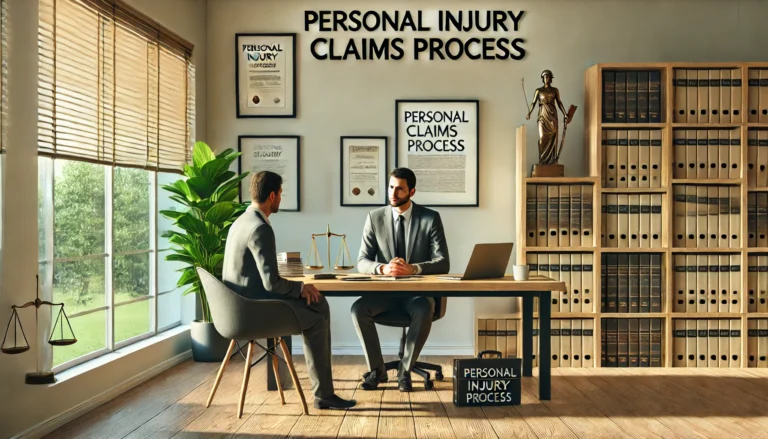Suffering a personal injury can be a life-altering experience. Beyond the physical pain and emotional distress, victims often face a confusing and overwhelming legal process in pursuit of compensation. Understanding the steps involved in a personal injury claim can help demystify the process, ensuring that you take the necessary actions to safeguard your rights and recover the compensation you deserve. This comprehensive guide outlines each critical stage of the personal injury claims process, from the initial incident to receiving compensation.
1. Seek Medical Attention Immediately
The very first step after any accident is to seek medical attention, even if you don’t immediately feel injured. Often, injuries like concussions, whiplash, or internal bleeding may not present symptoms right away, but delaying treatment can worsen your condition. More importantly, from a legal standpoint, seeking medical attention creates a formal medical record that links your injuries directly to the incident. This documentation will be essential for establishing the extent of your injuries in your claim.
Additionally, medical professionals may give you treatment plans or advice on necessary ongoing care. Following these medical instructions is critical, as failing to adhere to them can lead insurance companies or opposing counsel to argue that you are not as injured as you claim, thereby reducing the potential value of your compensation.
2. Report the Incident
Regardless of the type of accident—whether it’s a motor vehicle collision, a slip and fall, a workplace injury, or a medical malpractice issue—you need to officially report the incident as soon as possible. In car accidents, for instance, this means calling the police and filing an official accident report. In a workplace injury, it means notifying your employer and filing a worker’s compensation claim. For slip-and-fall cases on commercial property, reporting the event to the property manager or owner is crucial.
Creating an official report ensures that the incident is properly documented, providing another piece of vital evidence for your personal injury claim. It also serves to formalize the event, preventing the responsible party from disputing whether the accident occurred. Failure to report the incident promptly can weaken your case, as it may raise questions about the legitimacy of your claim.
3. Gather Evidence at the Scene
Gathering evidence is one of the most critical steps in building a strong personal injury claim. Start by collecting information and materials as soon as possible following the accident. If you are able, take photographs or videos of the accident scene, capturing anything that might be relevant. For example, in a car accident, this could include the position of the vehicles, any skid marks on the road, and visible damage. In a slip-and-fall case, photograph the hazard that caused your fall, whether it’s a wet floor, loose carpet, or poorly maintained stairs.
Additionally, be sure to collect witness statements. If there were any bystanders who witnessed the accident, get their contact information. Witness testimony can help corroborate your account of the event, especially in cases where liability is disputed.
Documentation is also essential for your medical treatment. Keep track of your medical bills, treatment receipts, prescriptions, and even travel costs related to doctor visits. You should also maintain a personal injury journal, where you record the details of your pain, discomfort, emotional distress, and how the injury affects your day-to-day life.
4. Consult with a Personal Injury Attorney
While handling a claim on your own is possible, consulting with an experienced personal injury attorney greatly improves your chances of securing fair personal injury compensation. Attorneys are well-versed in the intricacies of personal injury law, which allows them to navigate the legal process, negotiate effectively with insurance companies, and ensure all relevant evidence is presented. They also help in accurately assessing the full value of your personal injury compensation, taking into account not just immediate expenses like medical bills, but also long-term costs such as future medical care, lost wages, and emotional suffering. With professional legal guidance, you stand a better chance of receiving the compensation you truly deserve.
5. File a Personal Injury Claim
Once you’ve gathered sufficient evidence and consulted with a lawyer, the next step is to file a formal personal injury claim with the at-fault party’s insurance company. Your attorney will likely help you prepare the claim, which includes outlining the details of the incident, providing evidence of your injuries and expenses, and specifying the compensation you seek.
It’s crucial to be thorough in your claim. Include all supporting documentation, from medical reports and bills to witness statements and photos. Your claim should also cover all of your economic and non-economic damages. Economic damages include medical bills, rehabilitation costs, lost wages, and any other out-of-pocket expenses. Non-economic damages refer to more subjective losses, such as pain and suffering, emotional distress, and loss of enjoyment of life.
6. The Insurance Company’s Investigation
After you file your personal injury claim, the insurance company will conduct its own investigation into the accident. This investigation typically involves reviewing the evidence you’ve provided, speaking with witnesses, and possibly requesting additional medical evaluations.
Insurance companies are primarily concerned with protecting their financial interests, so they will scrutinize your claim carefully to look for any inconsistencies or opportunities to minimize their payout. They may try to argue that you were partially at fault for the accident, that your injuries aren’t as severe as claimed, or that the treatments you received weren’t necessary. This is why having a strong case, supported by ample evidence and medical documentation, is essential.
Summing Up
The personal injury claims process may seem complex, but understanding each step can help you feel more confident as you pursue compensation for your injuries. By seeking immediate medical attention, gathering crucial evidence, consulting with an attorney, and carefully navigating the claims process, you can improve your chances of securing a fair settlement. Remember, patience is key—this process can take time, but with the right preparation and legal guidance, you can successfully recover the compensation you deserve.

